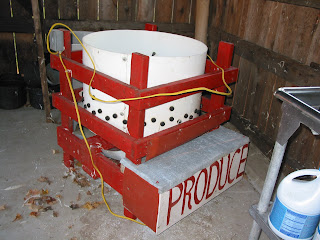Whizbang

Mark from Jericho Settlers Farm asked in the comments of my last post if the piece of red furniture in the background of one of the photo's was a Whizbang chicken plucker. It surely is, a 30 incher no less. When we decided to go into Pastured Poultry about 5 years ago we a had an old drum style chicken plucker. It had a drum that spun with a bunch of plucker fingers on the outside of it. You had to scald a chicken for about a minute, then hold it against the drum to remove the feathers, turning the chicken until it was bare. My wife and I started butchering our first batch of 72 at 9am, and we didn't finish until about 3 the next morning. Part of the trouble was lack of experience, but a big part was a lack of good equipment.
It didn't take too long to realize that if we were going to do this commercially that we would need more efficient equipment. I was all set to spend $1500 on a 27 inch tub style chicken plucker which would be able to handle 4 chickens at a time when I stumbled across a Yahoo group dedicated to the discussion of a book written by Herrick Kimball called "You Can Build a Tub Style Chicken Plucker".
I bought the book and a few weeks later I had a finished plucker. I decided to build a bigger one than the plans called for because I figured that the time may come when we were doing enough chickens to want to have the capacity to pluck 6 or so chickens at a time.
 The Gear Reduction
The Gear Reduction One of the problems we had with scaling the size up was that the outside edges of the feather plate (the aluminum disk in the bottom of the tub, which is studded with rubber plucker fingers) spins at a lot more feet per second than a smaller plate would which was causing too many broken wings and legs on the chickens. This also caused the 1.5 horsepower motor to barely have enough power to handle the job. I ended up putting a gear reduction into the machine in the form of a second shaft and pulley setup. This brought the featherplate RPM from 275 to 175, and reduced the power requirements substancially.
Since I made this modification I couldn't be happier with the plucker. It cost me about $400 to build and plucks the birds nice and clean. It can even handle a 42 pound (dressed weight) turkey.




